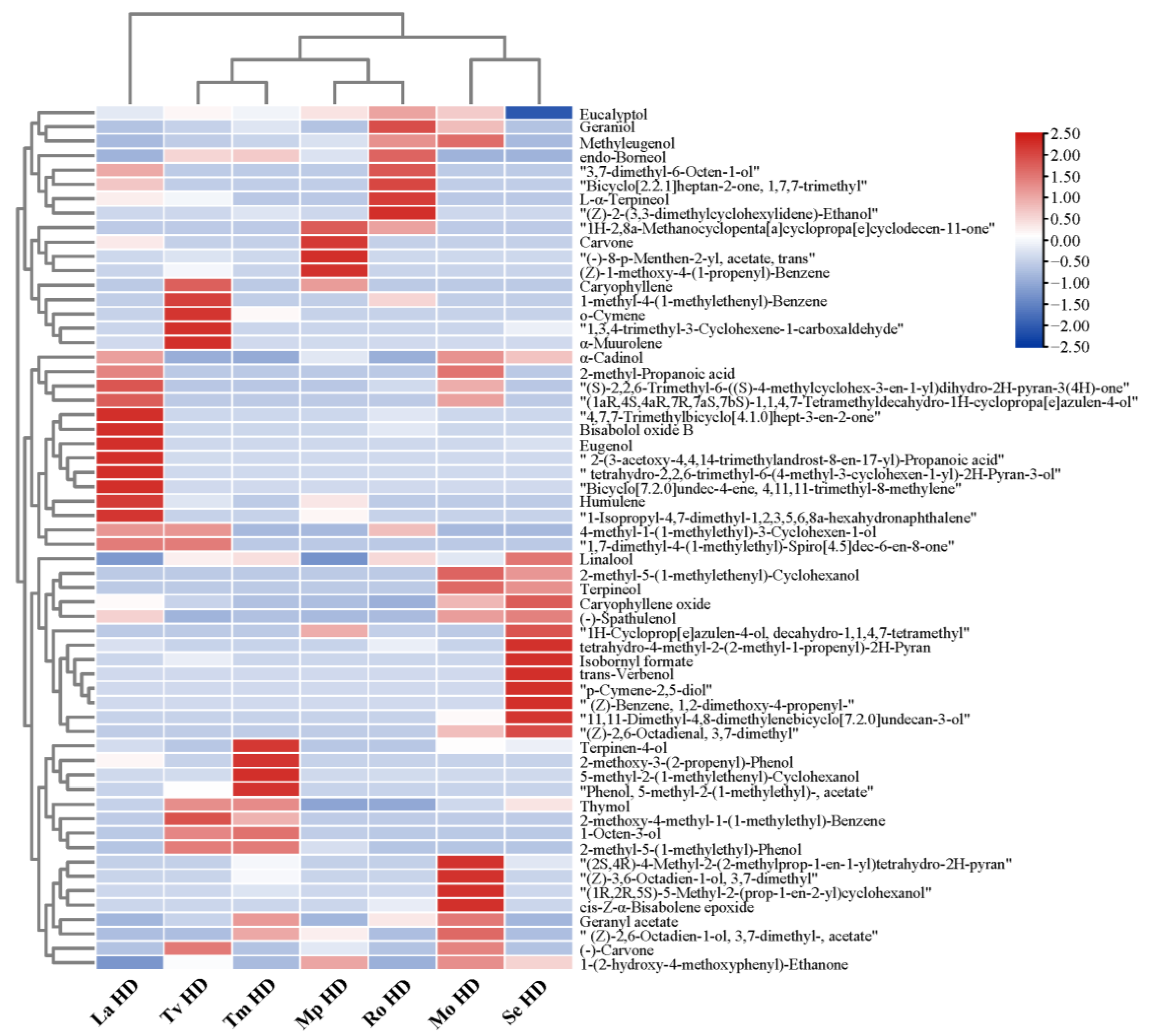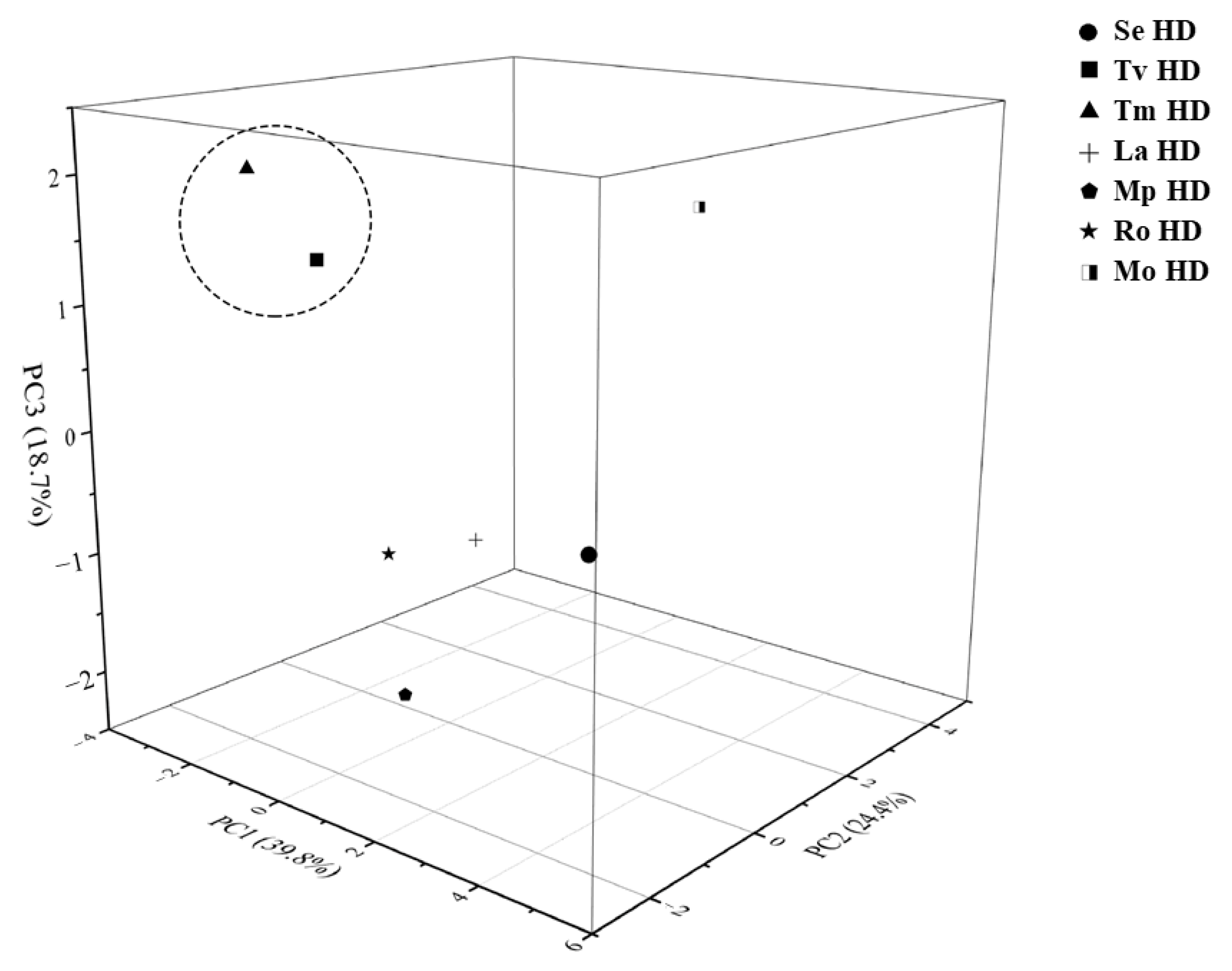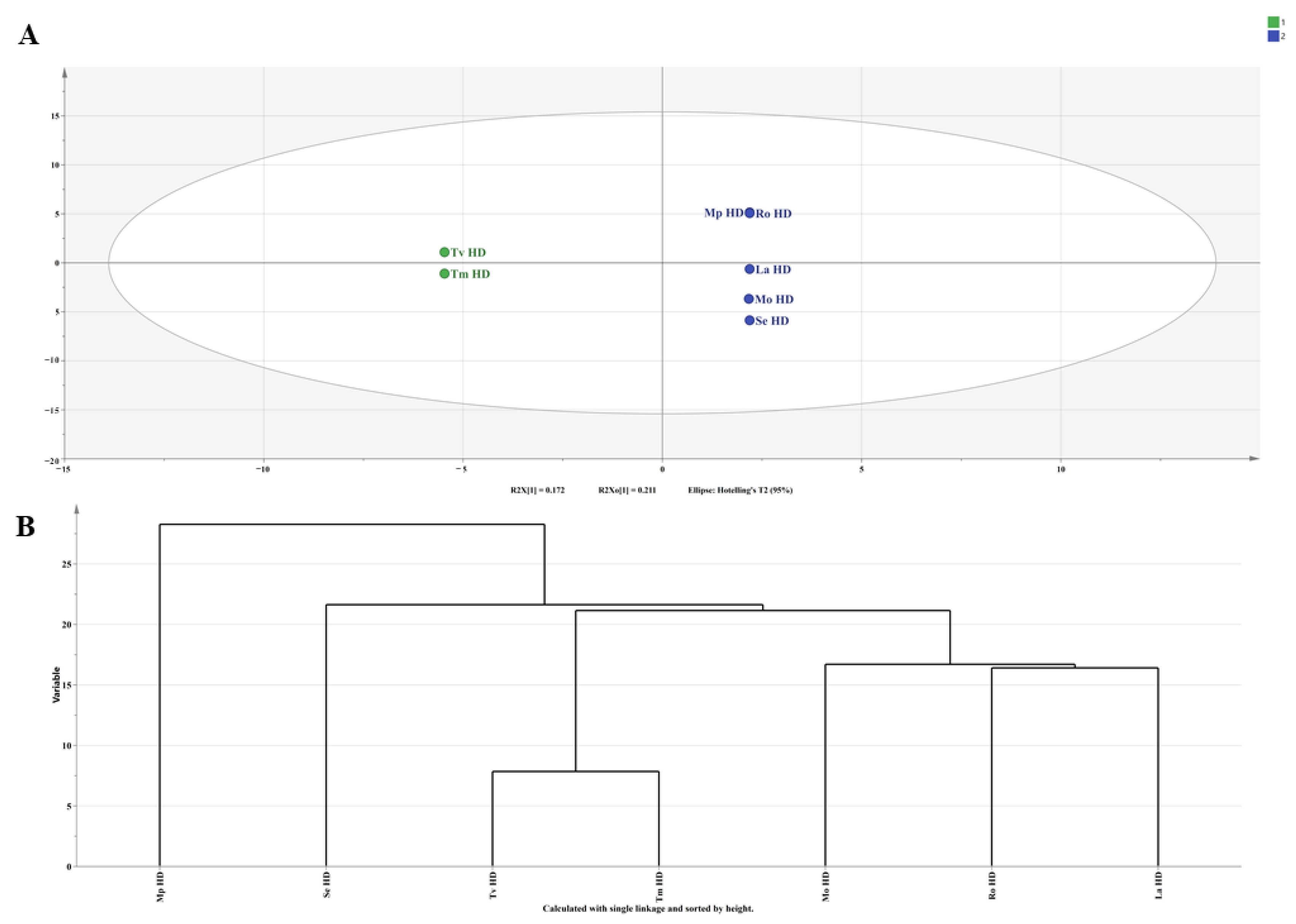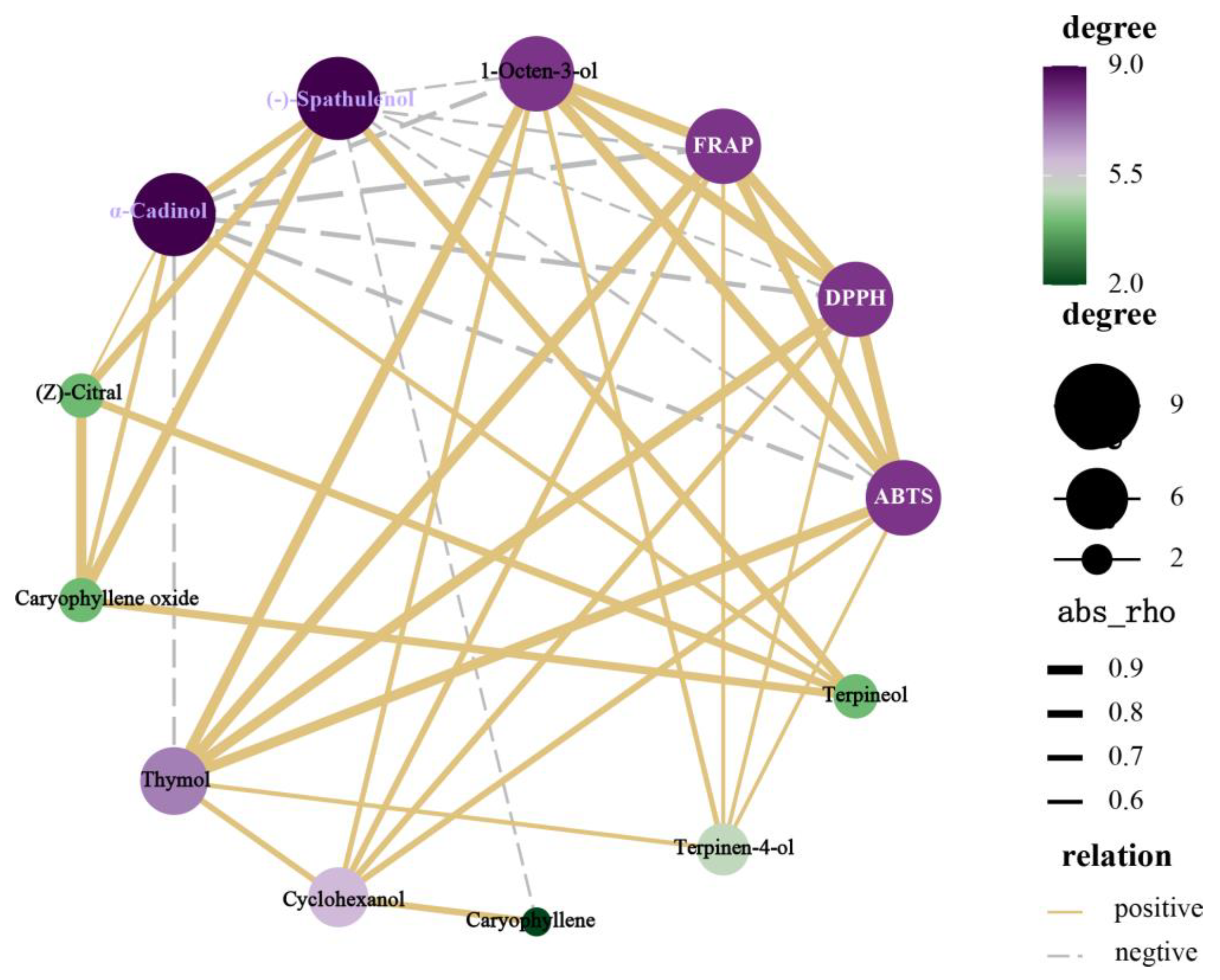Investigation of Volatile Components and Assessment of Antioxidant Potential in Seven Lamiaceae Plant Hydrosols
Abstract
:1. Introduction
2. Results and Discussion
2.1. GC-MS Analysis of Volatile Components of Seven Lamiaceae Hydrosols
2.2. Multivariate Analysis of Volatile Constituents of Seven Hydrosols from the Lamiaceae Family
2.3. In Vitro Antioxidant Activity Analysis of Seven Lamiaceae Hydrosols
2.4. Correlation Analysis between Volatile Components and Antioxidant Activity of Seven Lamiaceae Hydrosols
3. Materials and Methods
3.1. Plant Materials
3.2. Sample Extraction
3.3. Chemicals
3.4. GC-MS Analysis
3.5. Assessment of Antioxidant Activity with ABTS+•, DPPH•, and FRAP Assays
3.5.1. Determination of DPPH Free Radical Scavenging Capacity of Seven Lamiaceae Plant Hydrosols
3.5.2. Determination of ABTS Radical Scavenging Ability of Seven Lamiaceae Plant Hydrosols
3.5.3. Determination of Ferric-Reducing Antioxidant Power of Seven Lamiaceae Plant Hydrosols
3.6. Statistical Analysis
4. Conclusions
Supplementary Materials
Author Contributions
Funding
Institutional Review Board Statement
Informed Consent Statement
Data Availability Statement
Acknowledgments
Conflicts of Interest
References
- Aćimović, M.; Stanković Jeremić, J.S.; Miljković, A.; Rat, M.; Lončar, B. Screening of volatile compounds, traditional and modern phytotherapy approaches of selected non-aromatic medicinal plants (Lamiaceae, Lamioideae) from Rtanj mountain, Eastern Serbia. Molecules 2023, 28, 4611. [Google Scholar] [CrossRef] [PubMed]
- Lei, G.M.; Li, J.; Zheng, T.; Yao, J.Q.; Chen, J.J.; Duan, L.X. Comparative chemical profiles of essential oils and hydrolate extracts from fresh flowers of eight Paeonia suffruticosa Andr. Cultivars from central China. Molecules 2018, 23, 3268. [Google Scholar] [CrossRef] [PubMed]
- Lei, G.M.; Song, C.Y.; Wen, X.Y.; Gao, G.Y.; Qi, Y.J. Chemical Diversity and Potential Target Network of Woody peony Flower Essential Oil from Eleven Representative Cultivars (Paeonia × suffruticosa Andr.). Molecules 2022, 27, 2829. [Google Scholar] [CrossRef] [PubMed]
- Michalak, M. Plant-derived antioxidants: Significance in skin health and the ageing process. Int. J. Mol. Sci. 2022, 23, 585. [Google Scholar] [CrossRef] [PubMed]
- Bălănescu, F.; Botezatu, A.V.; Marques, F.; Busuioc, A.; Marincaş, O.; Vînătoru, C.; Cârâc, G.; Furdui, B.; Dinica, R.M. Bridging the chemical profile and biological activities of a new variety of Agastache foeniculum (Pursh) Kuntze extracts and essential oil. Int. J. Mol. Sci. 2023, 24, 828. [Google Scholar] [CrossRef] [PubMed]
- Kačániová, M.; Vukovic, N.L.; Čmiková, N.; Galovičová, L.; Schwarzová, M.; Šimora, V.; Kowalczewski, P.Ł.; Kluz, M.I.; Puchalski, C.; Bakay, L. Salvia sclarea essential oil chemical composition and biological activities. Int. J. Mol. Sci. 2023, 24, 5179. [Google Scholar] [CrossRef] [PubMed]
- Bezek, K.; Kramberger, K.; Barlič-Maganja, D. Antioxidant and antimicrobial properties of Helichrysum italicum (Roth) G. Don hydrosol. Antibiotics 2022, 11, 1017. [Google Scholar] [CrossRef]
- Aebisher, D.; Cichonski, J.; Szpyrka, E.; Masjonis, S.; Chrzanowski, G. Essential oils of seven Lamiaceae Plants and Their antioxidant capacity. Molecules 2021, 26, 3793. [Google Scholar] [CrossRef]
- Diniz do Nascimento, L.D.; de Moraes, A.A.B.; da Costa, K.S.; Pereira Galúcio, J.M.P.; Taube, P.S.; Costa, C.M.L.; Neves Cruz, J.N.; de Aguiar Andrade, E.H.D.; de Faria, L.J.G. Bioactive natural compounds and antioxidant activity of essential oils from spice plants: New findings and potential applications. Biomolecules 2020, 10, 988. [Google Scholar] [CrossRef]
- Gravina, C.; Formato, M.; Piccolella, S.; Fiorentino, M.; Stinca, A.; Pacifico, S.; Esposito, A. Lavandula austroapennina (Lamiaceae): Getting Insights into Bioactive Polyphenols of a Rare Italian Endemic Vascular Plant. Int. J. Mol. Sci. 2023, 24, 8038. [Google Scholar] [CrossRef]
- Salehi, B.; Mishra, A.P.; Shukla, I.; Sharifi-Rad, M.; Contreras, M.D.M.; Segura-Carretero, A.; Fathi, H.; Nasrabadi, N.N.; Kobarfard, F.; Sharifi-Rad, J. Thymol, thyme, and other plant sources: Health and potential uses. Phytother. Res. 2018, 32, 1688–1706. [Google Scholar] [CrossRef] [PubMed]
- Kavvoura, D.A.; Stefanakis, M.K.; Kletsas, D.; Katerinopoulos, H.E.; Pratsinis, H. Biological activities of Ceratonia siliqua Pod and Seed extracts: A comparative analysis of two Cretan cultivars. Int. J. Mol. Sci. 2023, 24, 12104. [Google Scholar] [CrossRef] [PubMed]
- Bozin, B.; Mimica-Dukic, N.; Simin, N.; Anackov, G. Characterization of the volatile composition of essential oils of some Lamiaceae spices and the antimicrobial and antioxidant activities of the entire oils. J. Agric. Food Chem. 2006, 54, 1822–1828. [Google Scholar] [CrossRef] [PubMed]
- Carović-Stanko, K.; Petek, M.; Grdiša, M.; Pintar, J.; Bedeković, D.; Herak Ćustić, M.; Satovic, Z. Medicinal plants of the family Lamiaceae as functional foods—A review. Czech J. Food Sci. 2016, 34, 377–390. [Google Scholar] [CrossRef]
- Mimica-Dukic, N.; Bozin, B.; Mentha, L. Species (Lamiaceae) as promising sources of bioactive secondary metabolites. Curr. Pharm. Des. 2008, 14, 3141–3150. [Google Scholar] [CrossRef]
- Maggi, F.; Mártonfi, P.; Conti, F.; Cristalli, G.; Papa, F.; Sagratini, G.; Vittori, S. Volatile components of whole and different plant parts of bastard balm (Melittis melissophyllum L., Lamiaceae) collected in central Italy and Slovakia. Chem. Biodivers. 2011, 8, 2057–2079. [Google Scholar] [CrossRef]
- Napoli, E.; Siracusa, L.; Ruberto, G. New tricks for old guys: Recent developments in the chemistry, biochemistry, applications and exploitation of selected species from the Lamiaceae Family. Chem. Biodivers. 2020, 17, e1900677. [Google Scholar] [CrossRef]
- Santos, A.A.; Farder-Gomes, C.F.; Ribeiro, A.V.; Costa, T.L.; França, J.C.O.; Bacci, L.; Demuner, A.J.; Serrão, J.E.; Picanço, M.C. Lethal and sublethal effects of an emulsion based on Pogostemon cablin (Lamiaceae) essential oil on the coffee berry borer, Hypothenemus hampei. Environ. Sci. Pollut. Res. Int. 2022, 29, 45763–45773. [Google Scholar] [CrossRef]
- Senatore, F.; Formisano, C.; Arnold, N.A.; Piozzi, F. Essential oils from Salvia sp. (Lamiaceae). III. Composition and antimicrobial activity of the essential oil of Salvia Palaestina Benth. growing wild in Lebanon. J. Essent. Oil Res. 2005, 17, 419–421. [Google Scholar] [CrossRef]
- Dudonné, S.; Vitrac, X.; Coutière, P.; Woillez, M.; Mérillon, J.M. Comparative study of antioxidant properties and total phenolic content of 30 plant extracts of industrial interest using DPPH, ABTS, FRAP, SOD, and ORAC assays. J. Agric. Food Chem. 2009, 57, 1768–1774. [Google Scholar] [CrossRef]
- Bagci, E.; Hayta, S.; Yazgin, A.; Dogan, G. Composition of the essential oil of Teucrium parviflorum L. (Lamiaceae) from Turkey. J. Med. Plants Res. 2011, 5, 3457–3460. [Google Scholar]
- Karpiński, T.M.; Ożarowski, M.; Seremak-Mrozikiewicz, A.; Wolski, H. Anti-candida and antibiofilm activity of selected Lamiaceae essential oils. Front. Biosci. (Landmark Ed.) 2023, 28, 28. [Google Scholar] [CrossRef] [PubMed]
- Borugă, O.; Jianu, C.; Mişcă, C.; Goleţ, I.; Gruia, A.T.; Horhat, F.G. Thymus vulgaris essential oil: Chemical composition and antimicrobial activity. J. Med. Life 2014, 7, 56–60. [Google Scholar] [PubMed]
- Gil, M.I.; Tomás-Barberán, F.A.; Hess-Pierce, B.; Holcroft, D.M.; Kader, A.A. Antioxidant activity of pomegranate juice and its relationship with phenolic composition and processing. J. Agric. Food Chem. 2000, 48, 4581–4589. [Google Scholar] [CrossRef] [PubMed]
- Zandi, P.; Ahmadi, L. Antioxidant effect of plant extracts of Labiatae family. J. Food Sci. Technol. Mysore 2000, 37, 436–439. [Google Scholar]
- Chipault, J.R.; Mizuno, G.R.; Hawkins, J.M.; Lundberg, W.O. The antioxidant properties of natural spices. Food Res. 1952, 17, 46–55. [Google Scholar] [CrossRef]
- Jianu, C.; Rusu, L.-C.; Muntean, I.; Cocan, I.; Lukinich-Gruia, A.T.; Goleț, I.; Horhat, D.; Mioc, M.; Mioc, A.; Șoica, C.; et al. In Vitro and In Silico Evaluation of the Antimicrobial and Antioxidant Potential of Thymus pulegioides Essential Oil. Antioxidant 2022, 11, 2472. [Google Scholar] [CrossRef]
- Jianu, C.; Goleț, I.; Stoin, D.; Cocan, I.; Lukinich-Gruia, A.T. Antioxidant Activity of Pastinaca sativa L. ssp. Sylvestris [Mill.] Rouy and Camus Essential Oil. Molecules 2020, 25, 869. [Google Scholar] [CrossRef]
- Rădulescu, M.; Jianu, C.; Lukinich-Gruia, A.T.; Mioc, M.; Mioc, A.; Șoica, C.; Stana, L.G. Chemical Composition, In Vitro and In Silico Antioxidant Potential of Melissa officinalis subsp. officinalis Essential Oil. Antioxidants 2021, 10, 1081. [Google Scholar] [CrossRef]
- Erdemoglu, N.; Turan, N.N.; Cakici, I.; Sener, B.; Aydin, A. Antioxidant activities of some Lamiaceae plant extracts. Phytother. Res. 2006, 20, 9–13. [Google Scholar] [CrossRef]
- Jianu, C.; Stoin, D.; Cocan, I.; David, I.; Pop, G.; Lukinich-Gruia, A.T.; Mioc, M.; Mioc, A.; Șoica, C.; Muntean, D.; et al. In Silico and In Vitro Evaluation of the Antimicrobial and Antioxidant Potential of Mentha × smithiana R. GRAHAM Essential Oil from Western Romania. Foods 2021, 10, 815. [Google Scholar] [CrossRef] [PubMed]
- Dorman, H.J.D.; Bachmayer, O.; Kosar, M.; Hiltunen, R. Antioxidant properties of aqueous extracts from selected Lamiaceae species grown in Turkey. J. Agric. Food Chem. 2004, 52, 762–770. [Google Scholar] [CrossRef] [PubMed]
- Omer Qader, K.; Malik Al-Saadi, S.A.A.; Hiwa Arif, H.; Al-Fekaiki, D.F. Antibacterial and Antioxidant Activity of Ziziphora clinopodioid Lam. (Lamiaceae) Essential Oil. Arch. Razi Inst. 2023, 78, 205–211. [Google Scholar] [CrossRef] [PubMed]
- Karpiński, T.M. Essential oils of Lamiaceae Family Plants as antifungals. Biomolecules 2020, 10, 103. [Google Scholar] [CrossRef] [PubMed]
- Ahangarpour, A.; Sayahi, M.; Sayahi, M. The antidiabetic and antioxidant properties of some phenolic phytochemicals: A review study. Diabetes Metab. Syndr. 2019, 13, 854–857. [Google Scholar] [CrossRef] [PubMed]
- Skendi, A.; Irakli, M.; Chatzopoulou, P. Analysis of phenolic compounds in Greek plants of Lamiaceae family by HPLC. J. Appl. Res. Med. Aromat. Plants 2017, 6, 62–69. [Google Scholar] [CrossRef]
- Andrés, M.F.; González-Coloma, A.; Muñoz, R.; De la Peña, F.; Julio, L.F.; Burillo, J. Nematicidal potential of hydrolates from the semi industrial vapor-pressure extraction of Spanish aromatic plants. Environ. Sci. Pollut. Res. Int. 2018, 25, 29834–29840. [Google Scholar] [CrossRef]
- Nanashima, N.; Kitajima, M.; Takamagi, S.; Fujioka, M.; Tomisawa, T. Comparison of chemical composition between Kuromoji (Lindera umbellata) essential oil and hydrosol and determination of the deodorizing effect. Molecules 2020, 25, 4195. [Google Scholar] [CrossRef]
- Pereira, I.; Severino, P.; Santos, A.C.; Silva, A.M.; Souto, E.B. Linalool bioactive properties and potential applicability in drug delivery systems. Colloids Surf. B Biointerfaces 2018, 171, 566–578. [Google Scholar] [CrossRef]
- Garneau, F.X.; Collin, G.; Gagnon, H.; Pichette, A. Chemical Composition of the Hydrosol and the Essential Oil of Three Different Species of the Pinaceae Family: Picea glauca (Moench) Voss., Picea mariana (Mill.) B.S.P., and Abies balsamea (L.) Mill. J. Essent. Oil Bear. Plants 2012, 15, 227–236. [Google Scholar] [CrossRef]
- Liu, S.T.; Zhao, C.; Cao, Y.W.; Li, Y.; Zhang, Z.; Nie, D.C.; Tang, W.X.; Li, Y.L. Comparison of chemical compositions and antioxidant activity of essential oils from Litsea Cubeba, cinnamon, anise, and Eucalyptus. Molecules 2023, 28, 5051. [Google Scholar] [CrossRef] [PubMed]
- Xin, Z.; Yang, W.; Duan, Y.; Wang, W.; Niu, L.; Sun, D.; Zhang, Y. Bioactive components and antibacterial activities of hydrolate extracts by optimization conditions from Paeonia ostii T. Hong & J.X. Zhang. Ind. Crops Prod. 2022, 188, 115737. [Google Scholar] [CrossRef]
- Yang, W.Z.; Xin, Z.W.; Xie, L.H.; Zhai, Y.H.; Zhang, Y.L.; Niu, L.X.; Zhang, Q.Y. Integrative lipidomics profile uncovers the mechanisms underlying high-level alpha-linolenic acid accumulation in Paeonia rockii seeds. Hortic. Res. 2023, 10, uhad106. [Google Scholar] [CrossRef] [PubMed]
- Quan, Y.; Yang, S.; Wan, J.; Su, T.T.; Zhang, J.; Wang, Z.Y. Optimization for the extraction of polysaccharides from Nostoc commune and its antioxidant and antibacterial activities. J. Taiwan Inst. Chem. Eng. 2015, 52, 14–21. [Google Scholar] [CrossRef]
- Jia, A.; Yang, Y.F.; Kong, D.Y.; Xiao, C.C. GC-MS analysis of chemical constituents of essential oil from Callicarpa kwangtungensis and their antimicrobial activity. Zhong Yao Cai Zhongyaocai J. Chin. Med. Mater. 2012, 35, 415–418. [Google Scholar]
- Xin, Z.W.; Yang, W.Z.; Niu, L.X.; Zhang, Y.L. Comprehensive metabolite profile uncovers the bioactive components, antioxidant and antibacterial activities in wild tree peony leaves. Int. J. Mol. Sci. 2023, 24, 10609. [Google Scholar] [CrossRef] [PubMed]
- Re, R.; Pellegrini, N.; Proteggente, A.; Pannala, A.; Yang, M.; Rice-Evans, C. Antioxidant activity applying an improved ABTS radical cation decolorization assay. Free Radic. Biol. Med. 1999, 26, 1231–1237. [Google Scholar] [CrossRef]
- Ou, B.X.; Hampsch-Woodill, M.; Prior, R.L. Development and validation of an improved oxygen radical absorbance capacity assay using fluorescein as the fluorescent probe. J. Agric. Food Chem. 2001, 49, 4619–4626. [Google Scholar] [CrossRef]
- Yang, W.Z.; Xin, Z.W.; Hu, J.Y.; Zhang, Y.L.; Zhang, Q.Y.; Niu, L.X. The tree peony nuclear factor Y transcription factor PrNF-YC2 promotes seed oil accumulation. Plant J. 2023, 115, 546–562. [Google Scholar] [CrossRef]
- Ji, X.; Xin, Z.; Yuan, Y.; Wang, M.; Lu, X.; Li, J.; Zhang, Y.; Niu, L.; Jiang, C.-Z.; Sun, D. A petunia transcription factor, PhOBF1, regulates flower senescence by modulating gibberellin biosynthesis. Hortic Res. 2023, 10, uhad022. [Google Scholar] [CrossRef]






| Tv HD | Tm HD | Mp HD | Mo HD | Ro HD | Se HD | La HD | |
|---|---|---|---|---|---|---|---|
| Esters | 0.84 | 0.7 | 0.5 | 3.29 | 2.47 | 0.84 | 2.64 |
| Olefins | 0.34 | 0.02 | 0.71 | 0.71 | 0.18 | 0.22 | 4.97 |
| Alkanes | tr | 0.12 | 0.04 | 0.1 | tr | 0.03 | 0.31 |
| Ethers | 10.57 | 7.19 | 5.88 | 10.69 | 7.7 | 2.46 | 3.75 |
| Aromatic Hydrocarbons | 2.51 | 0.36 | 0.13 | - | 0.02 | - | - |
| Ketones | 2.21 | 2.61 | 39.62 | 7.75 | 18.46 | 11.72 | 16.67 |
| Phenols | 20.78 | 21.78 | 0.25 | 1.37 | 0.11 | 5.51 | 4.41 |
| Alcohols | 12.73 | 16.52 | 2.86 | 25.55 | 21.03 | 28.48 | 11.5 |
| Others | 0.01 | 0.26 | 0.01 | 0.01 | 0.01 | 0.56 | 2.31 |
| DPPH (μmol TE/L DW) | ABTS (μmol TE/L DW) | FRAP (μmol TE/L DW) | |
|---|---|---|---|
| Tv HD | 174.04 ± 2.60 a | 451.79 ± 4.91 a | 204.02 ± 2.35 a |
| Tm HD | 170.92 ± 2.07 a | 447.93 ± 4.74 a | 199.75 ± 2.04 a |
| Mp HD | 76.00 ± 1.33 bc | 35.73 ± 1.86 d | 14.26 ± 2.47 c |
| Mo HD | 73.68 ± 1.91 bc | 28.00 ± 2.17 d | 7.52 ± 1.56 d |
| Ro HD | 75.84 ± 2.41 bc | 63.06 ± 2.05 b | 27.57 ± 1.72 b |
| Se HD | 70.53 ± 3.02 c | 48.89 ± 2.18 c | 18.72 ± 2.15 c |
| La HD | 78.59 ± 3.05 b | 44.86 ± 2.13 c | 15.81 ± 2.06 c |
| No. | Species | Abbreviations | Section | Extraction Parts |
|---|---|---|---|---|
| 1 | Thymus vulgaris | Tv HD | Lamiaceae | Branches and leaves |
| 2 | Thymus mongolicus | Tm HD | ||
| 3 | Mentha × piperita | Mp HD | ||
| 4 | Melissa officinalis | Mo HD | ||
| 5 | Rosmarinus officinali | Ro HD | ||
| 6 | Salvia elegans | Se HD | ||
| 7 | Leonurus artemisia | La HD |
Disclaimer/Publisher’s Note: The statements, opinions and data contained in all publications are solely those of the individual author(s) and contributor(s) and not of MDPI and/or the editor(s). MDPI and/or the editor(s) disclaim responsibility for any injury to people or property resulting from any ideas, methods, instructions or products referred to in the content. |
© 2023 by the authors. Licensee MDPI, Basel, Switzerland. This article is an open access article distributed under the terms and conditions of the Creative Commons Attribution (CC BY) license (https://creativecommons.org/licenses/by/4.0/).
Share and Cite
Xin, Z.; Wang, W.; Yang, W.; Li, Y.; Niu, L.; Zhang, Y. Investigation of Volatile Components and Assessment of Antioxidant Potential in Seven Lamiaceae Plant Hydrosols. Molecules 2024, 29, 145. https://doi.org/10.3390/molecules29010145
Xin Z, Wang W, Yang W, Li Y, Niu L, Zhang Y. Investigation of Volatile Components and Assessment of Antioxidant Potential in Seven Lamiaceae Plant Hydrosols. Molecules. 2024; 29(1):145. https://doi.org/10.3390/molecules29010145
Chicago/Turabian StyleXin, Ziwei, Wenjia Wang, Weizong Yang, Yajie Li, Lixin Niu, and Yanlong Zhang. 2024. "Investigation of Volatile Components and Assessment of Antioxidant Potential in Seven Lamiaceae Plant Hydrosols" Molecules 29, no. 1: 145. https://doi.org/10.3390/molecules29010145





